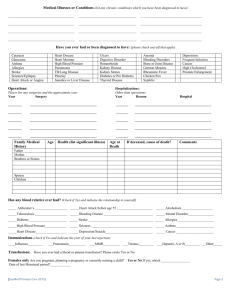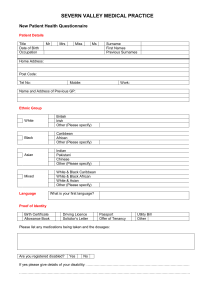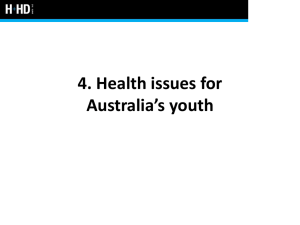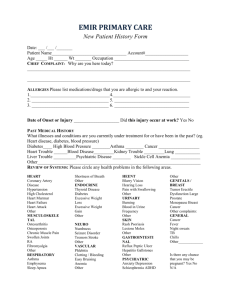ARTHRITIS IN AUSTRALIA - Doutta Galla Community Health
advertisement
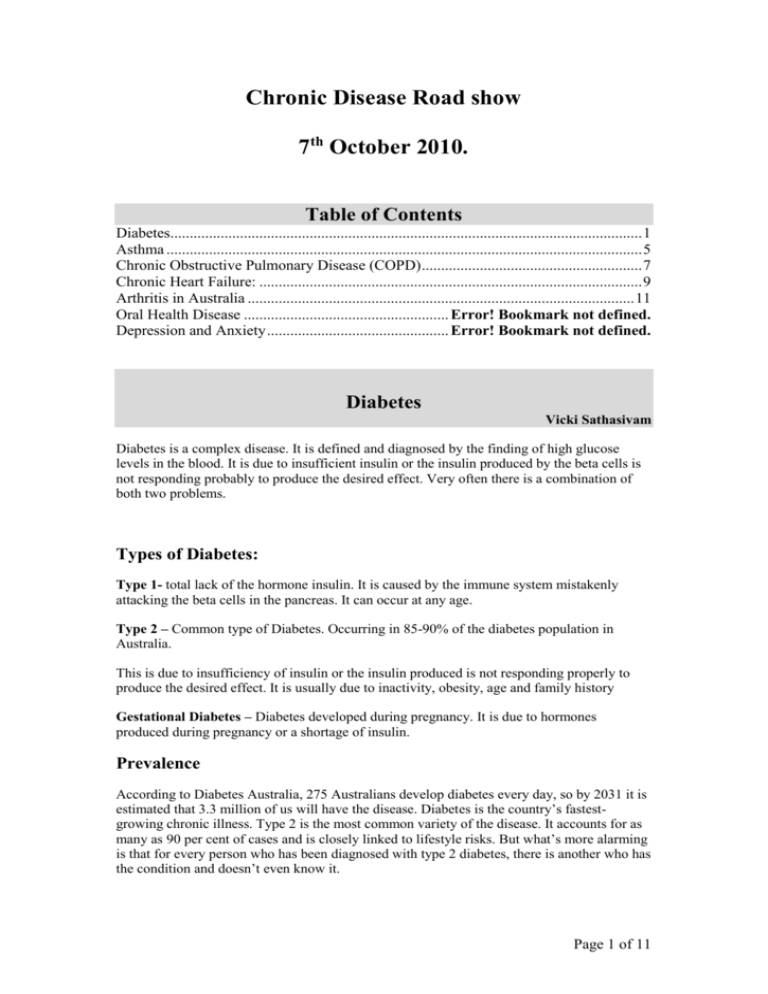
Chronic Disease Road show 7th October 2010. Table of Contents Diabetes.......................................................................................................................... 1 Asthma ........................................................................................................................... 5 Chronic Obstructive Pulmonary Disease (COPD) ......................................................... 7 Chronic Heart Failure: ................................................................................................... 9 Arthritis in Australia .................................................................................................... 11 Oral Health Disease ..................................................... Error! Bookmark not defined. Depression and Anxiety ............................................... Error! Bookmark not defined. Diabetes Vicki Sathasivam Diabetes is a complex disease. It is defined and diagnosed by the finding of high glucose levels in the blood. It is due to insufficient insulin or the insulin produced by the beta cells is not responding probably to produce the desired effect. Very often there is a combination of both two problems. Types of Diabetes: Type 1- total lack of the hormone insulin. It is caused by the immune system mistakenly attacking the beta cells in the pancreas. It can occur at any age. Type 2 – Common type of Diabetes. Occurring in 85-90% of the diabetes population in Australia. This is due to insufficiency of insulin or the insulin produced is not responding properly to produce the desired effect. It is usually due to inactivity, obesity, age and family history Gestational Diabetes – Diabetes developed during pregnancy. It is due to hormones produced during pregnancy or a shortage of insulin. Prevalence According to Diabetes Australia, 275 Australians develop diabetes every day, so by 2031 it is estimated that 3.3 million of us will have the disease. Diabetes is the country’s fastestgrowing chronic illness. Type 2 is the most common variety of the disease. It accounts for as many as 90 per cent of cases and is closely linked to lifestyle risks. But what’s more alarming is that for every person who has been diagnosed with type 2 diabetes, there is another who has the condition and doesn’t even know it. Page 1 of 11 MOONEE VALLEY metro Prevalence of diabetes: % of Population: LGA Ranking: Prevalence of diabetes: % of Population: LGA Ranking: 3,162 2.9% 57 3,680 3.4% 57 Prevalence by Age Impact In 2003, Diabetes and its complications were responsible for around 8% of the total burden of disease in Australia. 80 per cent of adults with diabetes will die from cardiovascular disease, including heart attack and stroke. It is the leading cause of end-stage kidney disease. Lower limb amputation is 15 times higher in people with diabetes than those without it. Diabetes is the leading cause of new cases of blindness among adults, age 20 – 74 The onset of macro vascular and micro vascular complications reduces quality of life and has a significant impact on affected individuals and their families. Page 2 of 11 Complications of Diabetes: Signs and Symptoms: Diabetes is a silent disease and when you get the signs and symptoms of diabetes, you probably have the disease for at least 5 year or more with tissue damage. Page 3 of 11 Service Providers Service providers involved in Care: General Practitioner, Diabetes Educators and Dieticians In screening and preventing complications: GP, Diabetes Educator, Dieticians, Podiatrists. Key Points to Remember Micro and Macro vascular complications are likely to occur if diabetes is poorly controlled. By controlling diabetes, these complications can be greatly reduced in most individuals. Treating other risk factors such as blood pressure and blood cholesterol levels reduce the risk of complications Even if despite good control, complications can develop. Early diagnosis helps, as effective treatment are available at the early stage of tissue damage. Annual Cycle of Care: 6 months to a Year which includes Blood test; - HBA1c, Kidney Function test, Blood Lipids and B/P. This is usually done by the GP. Diabetes Educator: Educate the clients to understand their disease process in relation to their blood findings and refer appropriately in accordance to their Glucose control. Dietician: If blood lipids are poorly control, dietary advice is given Podiatry: Annual neuro vascular review of lower limbs and rule out early peripheral vascular damage and neuropathy. Optician: To rule out retinopathy and macular degeneration Page 4 of 11 Asthma Michelle Norman What is it? Asthma is a reversible narrowing of the airways in the lungs. Asthma symptoms include wheezing, coughing (particularly at night), chest tightness, difficulty in breathing and shortness of breath. Asthma attacks can be brought on by a range of triggers including allergies, colds/infections, pollens, smoke, dust-mites etc The prevalence Asthma is an important health problem in Australia. Over 2 million Australians are currently diagnosed asthma. We have one of the highest rates of asthma in the world: between 14% and 16% of children and between 10% and 12% of adults have asthma. There is a strong link between asthma and allergy: more than 80%of people with asthma have evidence of allergic sensitisation. The presence of other allergic disorders (eczema or allergic rhinitis) or parental history of atopy are risk factors for persistent asthma at 6 years. The impact of the chronic condition on health Asthma affects different people in different ways, which is one reason why it is so hard to define and diagnose. But research is showing us that the process that leads to asthma starts very early in life – possibly before birth – and involves a complex interaction between genetic and environmental factors. Recent studies indicate that young children who are prone to asthma because their parents have allergies or asthma are likely to have lower lung function than normal even if they show no signs of wheezing or other asthma symptoms. This suggests that the process of asthma development is well under way in the early years of life, when the lungs develop most rapidly. There is much we still don’t know, especially about the environmental factors that contribute to asthma. Research is finding some clues, particularly about tobacco smoke, allergies, and the possible protective effect of infections. Asthma can impact on all areas of life including school, work, social interactions, development but Asthma is a manageable health condition. Although at the moment there is no cure, with good management people with asthma can lead normal, active lives. People with asthma report poorer general health and quality of life than people without asthma. More people with asthma suffer from anxiety and depression than people without asthma. Signs and symptoms Symptoms vary between individuals, but can include wheezing, a cough, shortness of breath. Page 5 of 11 Complications and what constitutes high risk If asthma is not well controlled, an acute exacerbation can occur. This could lead to hospitalization if symptoms can not be brought under control. Which service providers are usually involved in the care Medical practitioners, nurses, asthma educators, allied health staff all assist with managing a person’s asthma. Regular checks with a GP to update their Written Asthma Action Plan (WAAP) is essential. Annual cycle of care e.g. for asthma and diabetes The Asthma Cycle of Care can be provided by GPs to assist in managing a patient’s symptoms & triggers, to review their medication and device use and update their WAAP. Page 6 of 11 Chronic Obstructive Pulmonary Disease (COPD) Lisa Van Haster / Doris Brown What is it? Chronic Obstructive Pulmonary Disease (COPD) is a preventable and treatable disease with its pulmonary component characterised by airflow limitation which is not fully reversible. The airflow limitation is usually progressive and associated with an abnormal inflammatory response of the lung to noxious particles or gases (ie smoking, asbestosis). The Prevalence • Affects over 1 million Australians • Up to 1 in 6 over 45 has COPD • COPD is the 5th biggest killer of Australians. • 3rd leading cause of human & economic burden of disease (following coronary heart disease & stroke) (Australian Lung Foundation 2010) Impact of COPD on Health: • COPD costs Australia an estimated $800 to $900 million annually • On average, each day 1,740 people visit a GP for COPD • 1,000 COPD patients occupy hospital beds each day. Signs & Symptoms: • Shortness of breath on minimal exertion • A repetitive cough with phlegm / mucus most days (sometimes called a smoker's cough) • Not being able to take a deep breath Service Provides: • • • • • RMH Private Respiratory Physicians General Practitioners Other hospitals/ external HARP programs Community Health Care Workers (ie: nurses, physio’s) Page 7 of 11 Cycle of Care: Urgent: Does the client have acute worsening Shortness of breath? Requires immediate home intervention to prevent a Respiratory hospital admission? Semi Urgent: Does the client have newly prescribed home oxygen therapy? Does the client require Airway Clearance? Non Urgent: Does the client require Pulmonary Rehabilitation only? Does the client require Home Exercise and Education program only? PLAN OF CARE: Key worker role Specialist support-acute setting Facilitate D/C of Complex Patients D/C home visits Smoking cessation Action plans Medication Compliance End of life issues Page 8 of 11 Chronic Heart Failure: Pieta Price What is it? Is a term that means that the heart is not pumping efficiently enough to supply the body with sufficient blood for its needs. Background Recent Improvements in the treatment for medical and surgical treatment of heart disease and prolonged life expectancy and contributed to the increasing occurrence of CHF in older age There are approx 300,000 Australians with CHF. After discharge from hospital, unplanned readmission within 28 days is as high as 20% for CHF patients. Repeated admissions are common, as are attendances for acute management in emergency departments, followed by a return home within 24 hours. Most repeated hospital admissions are considered preventable. Multidisciplinary care model for managing Heart failure: Improved service delivery models with more effective use of costly resources resulting in reduced emergency department attendance, hospital admission and length of stay in hospital 2/3 CHF-related hospital admissions could be avoided by improved adherence to therapy, adequate access to medical and social support for patients and carers, and appropriate response to acute exacerbations or signs of deterioration. Sign and Symptoms: • • • • • • • Sudden weight gain. Swelling in the feet or abdomen. Loss of appetite, nausea or bloating. Light headedness, dizziness or fainting Shortness of breath, especially on exertion or lying flat. Dry hacking cough especially at night. Tiredness and fatigue. Those at most risk of ongoing complications and debilitation • • • • • • • • • Age >65 years of age Severe symptoms limiting activities of daily living LVEF <30% (On Echocardiogram) Living alone or remote from specialist cardiac services Depression Language barrier Lower socioeconomic status Significant renal dysfunction Increasing frailty and debilitation. Page 9 of 11 HARP Multidisciplinary Care model: Allocated Key Worker / Care Coordination • Referrals to other services – e.g.: ACAS, palliative care, council • Liaise with GP, medical staff, hospital, other care providers Home Visits • Education re CHF and self management • Monitor condition • Physiotherapy • Other HARP Services – e.g.: OT, medication management, care facilitation, Community Cardiology Clinic Home Exercise Program • 12 week physiotherapy program • Monitoring for 1 year Rehabilitation Program (10 weeks) • 2 x week • 1 hour exercise each session • 1 hour education/week (multi-disciplinary) • 1 hour of social group / week • Merri CHS in Coburg Maintenance Program (ongoing) • 1 x week • 1 hour exercise • 1 hour social group • Merri CHS in Coburg and Essendon (community church hall) Page 10 of 11 Arthritis in Australia Karin Roten What is it? “ Arth” = joint “-itis” = inflammation Includes problems with the bone/muscle/tendon/joints There are more than 100 conditions that fall under the term “arthritis” eg: Osteoarthritis, rheumatoid arthritis, osteoporosis, psoriatic arthritis, fibromyalgia, gout, ankylosing spondylitis, systemic lupus erythematosus Prevalence 1 in 5 Australians has a form of arthritis from one of the types of arthritis above The total cost to Australian Healthcare system is $4.2 billion per year (exceeding each of the following disease types: diabetes, stroke, depression, coronary heart disease and asthma) Signs and Symptoms Pain in joints and muscles, Fatigue Psychological effects Some conditions like Rheumatoid Arthritis have flares (an exacerbation of symptoms for a short time) and remission ( a reduction in symptoms) Can have problems with sleep, memory, concentration – as secondary issues Complications May require joint replacement surgery, arthroscopy, gait aids, other home modifications to help ADL’s Health Care team Rheumatologist, GP, Pharmacist, Orthopaedic surgeon, Physiotherapist, Podiatrist, Osteopath, Dietitian, Counsellor, Psychologist, Arthritis Victoria, Occupational Therapist, Exercise physiologist Annual cycle of care Regular reviews of medications to optimise pain relief Exercise to maintain strength of muscles supporting the joints and manage weight Specialist reviews to decide if surgery is appropriate DGCHS offers physiotherapy assessments and advice, exercise prescription and appropriate exercise classes like hydrotherapy and Living Longer Living Stronger Dietetics review is available, podiatry may be helpful for footwear advice Page 11 of 11
